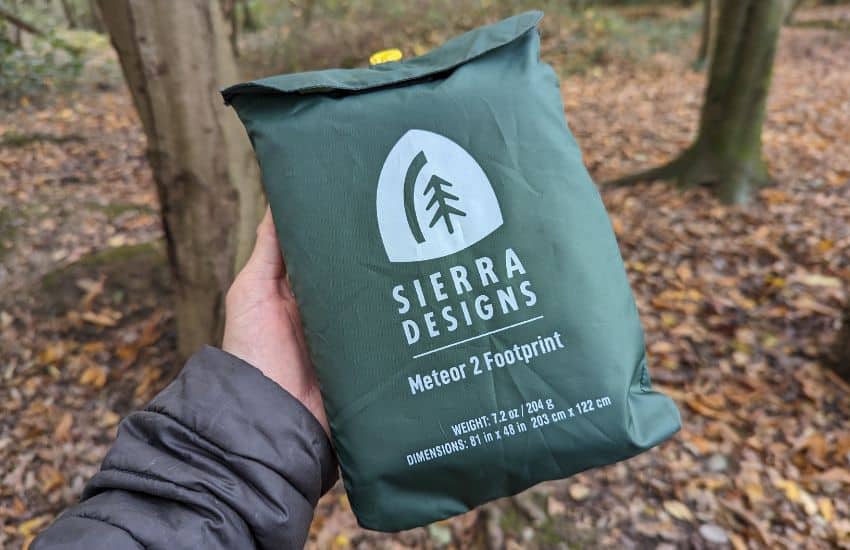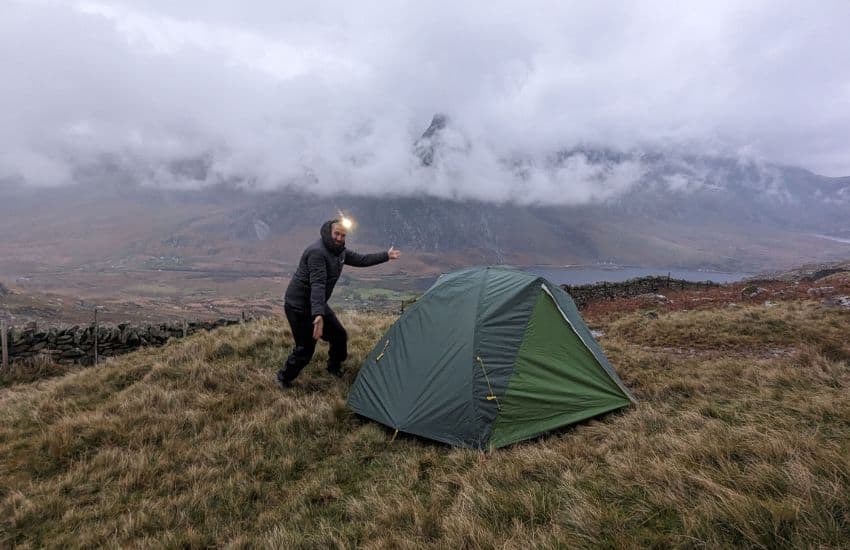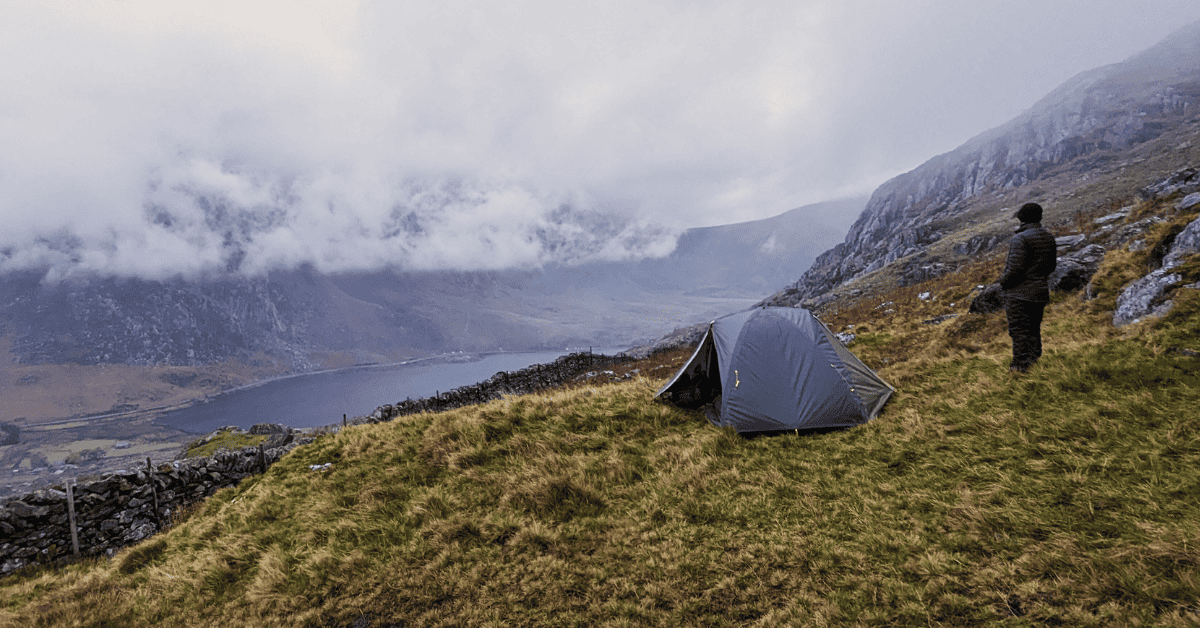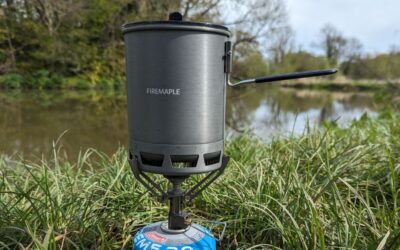Have you ever set up your backpacking tent, only to realize the ground beneath is more rugged than you anticipated? Or have you woken up from a restless night’s sleep feeling the dampness seeping in from below?
This is where understanding what a tent footprint is becomes crucial.
Setting up camp is an integral part of any outdoor adventure. However, the longevity of your tent and the comfort of your sleep can be compromised by harsh ground conditions.
Without proper ground protection, your tent is vulnerable to abrasions, punctures, and moisture. This not only shortens the lifespan of your tent but also impacts the chances of a cosy night’s sleep, turning what should be a restful experience into a night of discomfort.
Enter the Tent Footprint…

What is a Tent Footprint?
When you’re gearing up for a camping trip, one item that might not immediately come to mind is a tent footprint. Yet, it’s an essential component that can play a significant role in your outdoor experience.
A tent footprint, in its simplest form, is a groundsheet which is placed between the base of your tent and the cold ground. It’s made from waterproof materials, ensuring that moisture from the ground doesn’t seep into your tent. Commonly made from robust yet lightweight materials, tent footprints offer durability without adding much extra weight to your pack.
Most tent footprints are specifically designed to complement your tent but can also be found in various shapes and sizes, allowing you to find an ideal match for your specific setup. Whilst most tents don’t typically include a footprint as standard, there are numerous reasons why you might want to add one to your camping gear list.
Let’s delve into some key aspects of tent footprints, helping you understand their importance.
Disclaimer: If you make a purchase via the links on our site, I may earn an affiliate commission at no additional cost to you. You can read my affiliate disclosure in the privacy policy. Thanks for your support!
What are the Benefits of Using a Tent Footprint?
A tent footprint may seem like a simple addition to your wild camping setup, but the benefits extend beyond basic tent protection, offering a range of advantages that enhance your overall camping experience.
Here’s a look at some key reasons why a tent footprint is an invaluable addition to your outdoor adventures:
Additional Waterproofing
The role of a tent footprint in enhancing the waterproof capabilities of your camping setup cannot be overstated. Acting as an extra layer beneath your tent floor, the footprint acts as a robust barrier made from waterproof material.
This additional protection from the damp ground is vital in keeping the interior of your tent dry, especially when camping in wet or rainy environments, ensuring a more comfortable camping experience.
Extra Insulation
Incorporating a tent footprint into your camping setup offers more than just surface protection; it also adds a layer of extra insulation. This is crucial for reducing heat loss, especially in cooler climates or during colder nights.
While a sleeping pad provides individual warmth, the footprint extends this insulation across the entire tent floor, contributing to an overall increase in extra warmth. This added insulation is key in maintaining a comfortable temperature inside your tent, making for a better night’s sleep.
Protects Your Tent

This relatively simple yet effective piece will extend the life of your backpacking tent by acting as a protective layer, shielding it from ground-related wear and tear.
The footprint protects tent floors against abrasions, punctures, and general damage. This can make a huge difference in rugged or uneven camping terrains as it helps defend against sharp objects and rough ground, ensuring the tent’s fabric remains intact and functional over many years.
Reduces Cleaning
Another practical advantage of using a tent footprint is the reduced need for cleaning. By acting as a barrier, it keeps the tent bottom from coming into direct contact with mud, dirt, and debris.
This means less time spent scrubbing the tent clean after your trip, as most of the dirt and grime accumulates on the footprint instead, which is typically easier to clean.
Multi-Functional
The versatility of a tent footprint extends well beyond its primary use. It’s incredibly versatile, serving various functions at your campsite. For instance, it can be repurposed as a gear sorting station, keeping your equipment organized and off the ground. Additionally, in a pinch, a footprint can double as a picnic blanket, windbreak or even a rain tarp.
Find the Right Spot
Using a tent footprint can also aid in selecting the ideal spot for setting up your tent. By laying out the footprint first, you get a clear visual of the size and shape of your tent’s floor, making it easier to assess the suitability of the terrain.
How to Choose a Tent Footprint
When choosing a tent footprint, consider the following factors:
Durability: Choose a footprint made of a higher denier fabric for increased toughness and longevity. This is especially important if you frequently camp in rugged terrains. However, be mindful that more durable materials can increase the overall weight of the footprint.
Weight: It’s essential to strike a balance between durability and weight. For backpackers or those who need to minimize their load, opting for a lighter footprint is advisable. However, lighter materials might offer less protection against very rough surfaces.
Cost: While some tent manufacturers offer custom footprints that fit perfectly with their tent models, these can be more expensive. On the other hand, universal footprints can be a more budget-friendly choice and offer decent compatibility with various tent sizes. DIY footprints are another option which we’ll discuss shortly.
Make a DIY Footprint

If you’re not keen on the idea of buying a tent footprint, consider the DIY route as a customizable and budget-friendly alternative. DIY options for tent footprints can be surprisingly simple and effective, requiring just a few materials from a hardware store and some creativity.
In the next section, we’ll delve into how you can make your own tent footprint, providing a practical guide for those who prefer a hands-on approach to their camping gear.
Creating a DIY tent footprint is a practical and low-cost solution for campers looking to add an extra layer of protection under their tents. Here’s how you can make one using easily accessible materials:
Materials and Tools Needed:
Waterproof Tarpaulin or Fabric: Choose a durable, waterproof material like a polyethylene tarp or a heavy-duty nylon fabric. The material should be slightly larger than the dimensions of your tent’s floor.
Scissors or a Cutting Tool: Needed for trimming your fabric of choice.
Marker: To outline the cutting area on the material.
Measuring Tape: Essential for accurate measurements.
Grommet Kit (optional): If you want to add grommets to the corners of your footprint for easy pegging down.
Sealant (for nylon fabric): To seal the edges after cutting, preventing fraying.
Step-by-Step Guide:
1. Measure Your Tent’s Floor: Lay out your tent and measure the dimensions of its floor, noting the length and width.
2. Cut the Tarpaulin: Lay your waterproof tarpaulin flat and use the marker to outline the tent’s dimensions, adding an extra inch around the tent edge for adjustments. Cut along these lines with your scissors or cutting tool.
3. Seal the Edges: If you’re using nylon fabric, apply a sealant along the cut edges to prevent fraying. Allow it to dry thoroughly.
4. Insert Grommets (Optional): To securely anchor your footprint, insert grommets at each corner using the grommet kit. This step is particularly useful for windy conditions.
5. Test and Adjust: Place the cut tarpaulin under your tent to ensure a proper fit. The footprint should be slightly smaller than the tent’s floor to avoid water pooling. Trim any excess material if necessary.
6. Ready to Use: Your DIY tent footprint is now ready. It should align with your tent edges but not extend beyond it. Roll it up with your camping gear for easy transportation.
This approach to creating a tent footprint is not only low cost but also allows for customization to fit your specific tent size, providing a tailored solution to protect your tent from the ground elements.
How to Setup a Tent Footprint
Setting up a tent footprint is as straightforward as it comes: unfold and lay it flat on your chosen campsite, avoiding sharp rocks, sticks, or debris. Secure it with stakes if it has grommets or loops, then pitch your tent directly on top, aligning the edges. It really is as simple as that!
Final Thoughts
So are tent footprints worth it? Personally, I would say yes, especially if you are a regular camper who likes to explore beyond the boundaries of established campsites and camp throughout the year.
Adding a tent footprint to your camping setup, though an optional piece, can profoundly improve your overall camping experience.
The extra waterproofing it provides is invaluable, especially in damp conditions, keeping the inside of your tent dry and comfortable. Plus its puncture-resistant nature is a significant asset, protecting your tent from sharp objects and rough terrains.
While a tent footprint may not last forever, it significantly extends the lifespan of your tent, acting as a first line of defence against the natural elements.
In the end, the small investment in a tent footprint can pay off in big ways, from enhanced comfort to prolonged tent durability, making it a wise choice for any camper.
Tent Footprint FAQ
Can I make my own footprint?
Yes, you can make your own tent footprint. It’s a straightforward DIY project that involves cutting a durable, waterproof fabric, like a tarpaulin, to fit just under the size of your tent’s base. Adding grommets for securing it to the ground is also an option.
Should a footprint be bigger or smaller than the tent?
A tent will need a footprint that is marginally smaller than the tent floor. If it’s larger, it can collect water between the footprint and the tent floor during rain, leading to potential moisture problems.
Can you use a tent without a footprint?
Yes, you can use a tent without a footprint, but using one provides additional protection against ground moisture, wear and tear, and can extend the life of your tent.
Can I use a tarp instead of a tent footprint?
Absolutely. A tarp can serve as an effective tent footprint. Just ensure it’s cut to a size slightly smaller than your tent’s base to prevent water pooling.
Do you peg down a tent footprint?
It’s advisable to peg down a tent footprint if it has grommets or loops. This keeps it in place, ensuring it provides effective protection and doesn’t shift or bunch up under the tent.
What is the difference between a tarp and a footprint?
The main difference is that a footprint is specifically designed to fit a tent’s dimensions and is often made of lighter, more packable material. A tarp is more versatile and can be used for various purposes but might be bulkier and require trimming to fit your tent’s size.
Do You Need a Tent Footprint for Backpacking?
While not strictly necessary, a tent footprint is highly recommended for backpacking. It adds minimal weight but provides valuable protection for your tent, especially when camping on rough terrain. This can be crucial for lightweight backpacking tents that might have thinner floors.

About the Author
Steve Cleverdon is an adventure blogger dedicated to helping outdoor enthusiasts make the most of their outdoor experiences. With years of travel and many epic adventures including a 3000-kilometre solo hike across New Zealand, Steve has amassed practical knowledge on outdoor gear. You can learn more about his adventures here. Through expert reviews, recommendations, and guides, he equips his readers with the best gear for their next adventure. If you want to send Steve a quick message, visit his contact page here.




